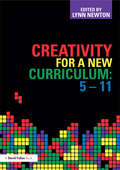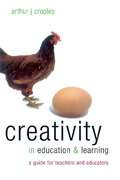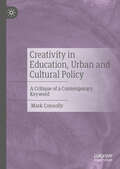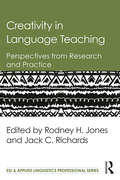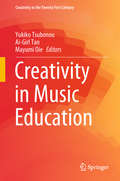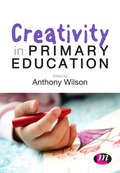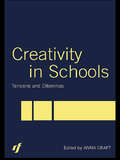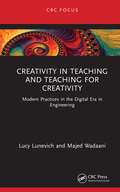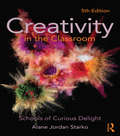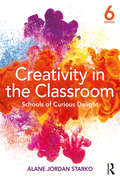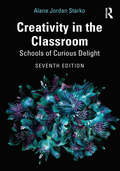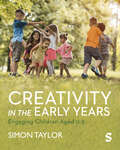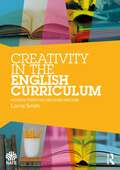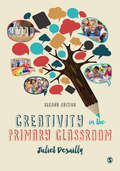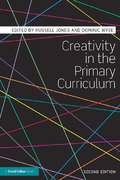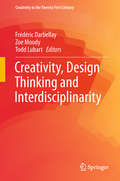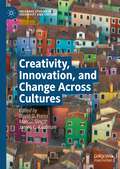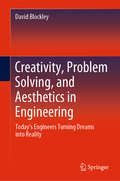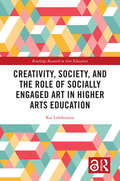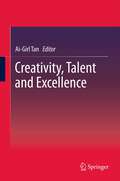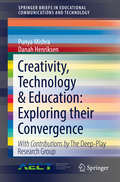- Table View
- List View
Creativity for a New Curriculum: 5-11
by Lynn D NewtonCreativity for a New Curriculum: 5-11 provides an account of what creativity really means in the context of children’s learning in the primary school, and describes in practical terms what teachers can do to foster it. At a time of curriculum development and change, it focuses on the opportunity to build a new curriculum that is inclusive of creativity and is fit for the twenty-first century. The value of fostering creative thinking and problem solving abilities in education is widely recognised for its capacity to confer an independence and ability to function effectively in life. As such, encouraging children to be creative thinkers and problem solvers should be an integral part of everyday teaching and learning across all subjects. Building upon the research and practices of a group of educators studying creativity across the curriculum and coordinated by the author, this book provides primary teachers and trainee teachers with easy to understand explanations of what creativity means in the context of the subjects of the curriculum for young children. It introduces ideas for how to nurture and support it, and explores issues associated with fostering it, such as assessment. Chapters cover areas including: A brief history of creativity and pedagogy, including common misconceptions Strategies for creative learning as well as creative teaching Creativity in English Creativity in Mathematics Creativity in Science and Design and Technology Creativity in Art and Music Creativity in History and the Humanities Creativity in ICT International perspectives on creativity Creativity for a New Curriculum: 5-11 is an ideal source of information for teachers, teacher trainers, students on teaching programmes and anyone interested in developing opportunities for creativity across the primary school curriculum.
Creativity in Education and Learning: A Guide for Teachers and Educators
by Arthur J. CropleyA study of creativity in the context of education, an issue of great importance for teachers and students alike. It considers just how creativity "works" and how it can be encouraged. The book has an international and an historical sweep, and features many examples.
Creativity in Education, Urban and Cultural Policy: A Critique of a Contemporary Keyword
by Mark ConnollyThis book critiques creativity as a ‘keyword’ in contemporary society. This is illustrated through an analysis of the uses of creativity within cultural, urban and educational policy. While there have been critiques and debates of the uses of creativity within these fields, the author innovatively bridges these disciplines by providing both an overview of the philosophical and ideological underpinnings of these debates and illustration of how they manifest in these distinct, yet interrelated policy spheres. Drawing on Raymond Williams’ theory of culture as social communication and keyword approach, the book illustrates how the creative turn in contemporary policy can divert attention from structural analysis and provide a rhetorical gloss for inequitable social policies. It will appeal to academics, students and practitioners involved in education, cultural and urban studies.
Creativity in Language Teaching: Perspectives from Research and Practice (ESL & Applied Linguistics Professional Series)
by Jack C. Richards Rodney H. JonesCurrent, comprehensive, and authoritative, this text gives language teachers and researchers, both a set of conceptual tools with which to think and talk about creativity in language teaching and a wealth of practical advice about principles and practices that can be applied to making their lessons more creative. Providing an overview of the nature of creativity and its role in second language education, it brings together twenty prominent language teachers and researchers with expertise in different aspects of creativity and teaching contexts to present a range of theories on both creative processes and how these processes lead to creative practices in language teaching. Unique in the field, the book takes a broader and more critical look at the notion of creativity in language learning, exploring its linguistic, cognitive, sociocultural and pedagogic dimensions. Structured in four sections— theoretical perspectives, creativity in the classroom, creativity in the curriculum, and creativity in teacher development—each chapter is supplemented by Questions for Discussion and Suggestions for Further Research. Its accessible style makes the book relevant as both a course text and a resource for practicing teachers.
Creativity in Music Education (Creativity In The Twenty First Century Ser.)
by Ai-Girl Tan Yukiko Tsubonou Mayumi OieThis book creates a platform for music educators to share their experience and expertise in creative music teaching and learning with the international community. It presents research studies and practices that are original and representative of music education in the Japanese, Asian and international communities. It also collects substantial literature on music education research in Japan and other Asian societies, enabling English-speaking readers to access excellent research and practical experiences in non-English societies.
Creativity in Primary Education (Achieving QTS Series)
by Dr Anthony Wilson"An alien spaceship crash landed in my playground today" For one primary school in England, this was not an ordinary day. It was a fabulous day of inspiration, writing, drawing, discovering and learning for the pupils, the staff and the parents. But the best thing of all? The only truly out of the ordinary thing was the alien spaceship. So how do you make creativity a more everyday part of primary teaching? Teachers and trainees agree that creativity is a fabulous thing. But to get creative approaches into everyday teaching, you need to tackle the question - what is creativity? This book explores this question in an accessible and practical way. It helps trainees to do more than 'know it when they see it', by helping them to understand the separate and very diverse elements of creativity. The third edition of this popular text retains key material, but it has been updated and revised to include two new chapters on the creative curriculum, along with links throughout to the Standards and the new National Curriculum. This book will help you enhance your teaching so you and the children in your class can be: fellow explorers, adventurous discoverers and spontaneous investigators!
Creativity in Schools: Tensions and Dilemmas
by Anna CraftCreativity in schools is changing, with greater emphasis being placed on creative skills across the curriculum than ever before. This shift has thrown up some challenging questions which this book tackles head-on in order to better understand the implications of this change and the effects on pedagogy and policy. The questions raised include: What is creative learning? How does it relate to creative teaching? How do we organize the curriculum to nurture creativity? What pedagogical strategies support creativity? How is creative learning different to effective learning? What responsibilities do schools have for stimulating creativity in relation to society, ethics and the wider environment? Laying out the key concepts in the current debate on creativity and placing them in a broader context based on practice, policy and research, this volume sets the agenda for future discussion and suggests practical ways to encourage pupils’ creative development in a new and more thoughtful way.
Creativity in Secondary Education (Achieving QTS Cross-Curricular Strand Series)
by Martin Fautley Jonathan SavageCreativity is increasingly seen as central to good learning and teaching throughout the curriculum. This book examines the political and educational context behind such developments and looks at dilemmas faced by trainee teachers as they begin their teaching practice. Demonstrating what creativity is, how it evolves and how it can be nurtured in various teaching contexts, it enables trainees to develop creativity in their teaching role and in their pupils′ learning. Throughout, the book links clearly to the new Professional Standards for QTS and presents exercises, subject-based case studies and teaching examples to engage and support all secondary trainees.
Creativity in Teaching and Teaching for Creativity: Modern Practices in the Digital Era in Engineering
by Lucy Lunevich Majed Rabhan WadaaniIn this book, the authors write about creativity in teaching and how to enhance creativity in learners. They highlight the new reality of teaching and learning in the digital era, specifically the impact of artificial intelligence, data economy, and artificial minds on modern teaching practices, curriculum design, and the role of teachers in classrooms. Creativity in Teaching and Teaching for Creativity: Modern Practices in the Digital Era approaches human intelligence as a universal gift. It emphasizes that the creativity of human beings is not only a natural quality, but one that can be enhanced as a result of learning. The book suggests new teaching models and approaches and discusses how the role of teachers in the classroom has fundamentally changed, emphasizing the emotional connection between students and teachers. The book will find interest among higher education policymakers who believe in the transformation of the education industry, research scholars who are pursuing their Ph.D. in the fields of education technology and education and learning, as well as those working in the area of education technology and artificial intelligence.
Creativity in the Classroom: Schools of Curious Delight
by Alane Jordan StarkoCreativity in the Classroom, Fifth Edition, helps teachers apply up-to-date research on creativity to their everyday classroom practice. Early chapters explore theories of creativity and talent development, while later chapters focus on practice, providing plentiful real-world applications-- from strategies designed to teach creative thinking to guidelines for teaching core content in ways that support student creativity. Attention is also given to classroom organization, motivation, and assessment. New to this edition: * Common Core State Standards--Updated coverage includes guidelines for teaching for creativity within a culture of educational standards. * Technology--Each chapter now includes tips for teaching with technology in ways that support creativity. * Assessment--A new, full chapter on assessment provides strategies for assessing creativity and ideas for classroom assessment that support creativity. * Creativity in the Classroom Models--New graphics highlight the relationships among creativity, learning for understanding, and motivation. The 5th edition of this well-loved text continues in the tradition of its predecessors, providing both theoretical and practical material that will be useful to teachers for years to come.
Creativity in the Classroom: Schools of Curious Delight
by Alane Jordan StarkoCreativity in the Classroom, sixth edition, helps teachers link creativity research and theory to the everyday activities of classroom teaching. This foundational textbook is relevant for any course dealing wholly or partially with creativity and teaching. The sixth edition has been revised and updated throughout, informed by cutting-edge research on neurobiology, curiosity and imaginative play, questioning, and motivation, particularly the relationships among creativity, intrinsic motivation, and motivation to learn.
Creativity in the Classroom: Schools of Curious Delight
by Alane Jordan StarkoNow in its seventh edition, Creativity in the Classroom helps teachers link creativity research and theory to the everyday activities of classroom teaching. Ideal reading for any course dealing wholly or partially with creativity and teaching, this foundational textbook covers definitions, research, and theory in the first half, and reflects on classroom practices in the second. Thoroughly revised and updated, the seventh edition features new research on neuroscience and creativity in specific disciplines; new sections on social-emotional learning, teaching engineering, and leadership; and an entire new chapter on building creativity at the school or district level.
Creativity in the Design Process: Exploring the Influences of the Digital Evolution (Springer Series in Design and Innovation #18)
by Carmen BrunoThe book provides an open and integrated view of creativity in the 21st century, merging theories and case studies from design, psychology, sociology, computer science and human-computer interaction, while benefitting from a continuous dialogue within a network of experts in these fields. An exploratory journey guides the reader through the major social, human, and technological changes that influence human creative abilities, highlighting the fundamental factors that need to be stimulated for creative empowerment in the digital era. The book reflects on why and how design practice and design research should explore digital creativity, and promote the empowerment of creativity, presenting two flexible tools specifically developed to observe the influences on multiple level of human creativity in the digital transition, and understand their positive and negative effect on the creative design process. An overview of the main influences and opportunities collected by adopting the two tools are presented with guidelines to design actions to empower the process for innovation.
Creativity in the Early Years: Engaging Children Aged 0-5
by Simon TaylorThis book offers an accessible and comprehensive new introduction to the subject and practise of creativity in early years education. Taylor takes a uniquely rights-based and inclusive approach to creativity, providing students with a holistic, internationally-minded overview of creativity and its place both inside and outside the classroom. Sections focus on: Defining creativity and its benefits Different modes of creativity Creativity in a policy and social context Creative pedagogy in practice Creative leadership Each chapter offers questions for critical reflection, illustrative contemporary case studies, and ample suggestions for further reading.
Creativity in the Early Years: Engaging Children Aged 0-5
by Simon TaylorThis book offers an accessible and comprehensive new introduction to the subject and practise of creativity in early years education. Taylor takes a uniquely rights-based and inclusive approach to creativity, providing students with a holistic, internationally-minded overview of creativity and its place both inside and outside the classroom. Sections focus on: Defining creativity and its benefits Different modes of creativity Creativity in a policy and social context Creative pedagogy in practice Creative leadership Each chapter offers questions for critical reflection, illustrative contemporary case studies, and ample suggestions for further reading.
Creativity in the English Curriculum: Historical Perspectives and Future Directions (National Association for the Teaching of English (NATE))
by Lorna SmithCreativity in the English Curriculum is essential reading for anyone involved or interested in the teaching of English, offering both a detailed history of how creativity has informed the tradition of teaching English, and how it should be used to position this teaching in the future. Highlighting the need to promote creativity as a rich, intellectual pursuit, Creativity in the English Curriculum celebrates artistry in English past and present, and argues for its restoration to the curriculum. It emphasises that creativity is at the core of a humane education, not only through stimulating and enhancing the growth of the individual, but also through developing understanding of the importance of community, society and collaboration. Smith presents the historical relationship between curriculum policy and creativity, demonstrating that creativity has and always will be the life blood of teaching and learning. Including dialogues between expert English teaching practitioners and leading professionals concerning the place of creativity in English, Creativity in the English Curriculum includes practical, research-informed ideas for effective creative practice for any English classroom. It is a must-read for teachers, educators, parents and guardians to prepare all learners for life in and beyond school.
Creativity in the Primary Classroom
by Juliet Desailly‘A highly practical overview of creative teaching and learning for both novice and seasoned primary teachers; this second edition features useful content on the new National Curriculum in England, such as possibilities for creativity in different subjects and consideration of creative assessment. In a nutshell, super-accessible and inspiring!’ -Emese Hall, PGCE Primary Lead & MA Creative Arts in Education Tutor, University of Exeter Creativity is an integral element of any primary classroom, and the new curriculum allows greater freedom than ever before to incorporate this in your teaching. Being a creative teacher involves generating new ideas, reflecting upon and evaluating different teaching approaches, and establishing an environment that supports creativity in your pupils. Filled with ideas, activities and reflective tasks and underpinned by relevant theory, this practical book explores how to develop as a creative teacher, empowering you to implement your own engaging and inspiring approaches to planning, teaching and assessment. Drawing from detailed real-life examples, this second edition includes: · Updated links to the new National Curriculum and Teachers’ Standards · More guidance for each curriculum subject area · Increased coverage of assessment and creative teaching for differentiation
Creativity in the Primary Classroom
by Juliet DesaillyCreativity is an integral element of any primary classroom. It has been never more important for teachers to involve children in their own learning and provide a curriculum that motivates and engages. Being a creative teacher involves generating new ideas, reflecting upon and evaluating different teaching approaches, and establishing an environment that supports creativity in your pupils. Creativity in the Primary Classroom explores how to develop as a creative teacher and how to foster creativity in your classes. Drawing from key literature and detailed real-life examples, Juliet Desailly puts into practice her extensive experience planning, advising and developing creative approaches to teaching and curriculum planning. This book examines what creativity in a primary classroom can look like, and is supported throughout by practical activities for use across curriculum subjects and reflective tasks encouraging critical engagement with key conceptual issues. This is essential reading for students on primary initial teacher education courses including undergraduate (BEd, BA with QTS), postgraduate (PGCE, SCITT), and employment-based routes into teaching, and also for practicing teachers wishing to enhance their own teaching. Juliet Desailly, formerly PGCE Tutor in Primary Education at the Institute of Education, London, is a freelance Educational Consultant. 'This book deepens and broadens our understandings of creativity as applied to primary education. It provides a balance of practical frameworks and approaches with wise guidance. Many schools and individual teachers will find Juliet Desailly's work invaluable as they embrace the greater pedagogical and curricular freedoms promised by government.' - Jonathan Barnes, Senior lecturer in Primary Education at Canterbury Christ Church University.
Creativity in the Primary Curriculum
by Russell Jones and Dominic WyseAre you striving to establish a more creative and imaginative classroom? Are you interested in: the generosity of creativity; creative conjecture; being an advocate for creativity; welcoming the unexpected, the unpredictable and the unconventional; taking risks; learning which leads to new or original thinking which is of value? If so, this completely updated new edition of a classic text will show you how to achieve these ideals. The book is written in a clear and practical way by leading researchers and practitioners, offering help and advice on the planning and implementation of effective creative teaching and learning, and providing examples of best practice through a rigorous theoretical rationale. A hallmark of the book is its exploration of creativity through curriculum subjects. It builds on this in its first and last chapters by addressing key cross-curricular themes that thread their way throughout the book. Throughout there is an emphasis on critical and reflective practice. New to this edition are: three entirely new chapters on drama, music and geography; an update of the introduction to account for advances in creativity research, policy and practice; a new final chapter identifying cross-curricular themes; greater attention to international dimensions and examples. In this second edition the authors are drawn from six universities which between them produce some of the best education research internationally, and some of the best teacher education. The authors also come from leading national and international organisations such as the National Gallery in London and the Geographical Association. Creaivity for the Primary Curriculum is a core text for both training and practicing Primary teachers who wish to maintain high standards when approaching their teaching.
Creativity, Design Thinking and Interdisciplinarity (Creativity in the Twenty First Century)
by Frédéric Darbellay Zoe Moody Todd LubartThis book, at the crossroads of creativity, design and interdisciplinary studies, offers an overview of these major trends in scientific research, society, culture and economics. It brings together different approaches and communities around a common reflection on interdisciplinary creative design thinking. This collective effort provides a unique dialogical and convergent space that deals with the challenges and opportunities met by researchers and practitioners working on design thinking, creativity and inter- and transdisciplinarity, or at the interface between these areas.
Creativity, Innovation, and Change Across Cultures (Palgrave Studies in Creativity and Culture)
by James C. Kaufman Marcos Singer David D. PreissThis book offers interdisciplinary, multicultural, and international perspectives on the interrelation between culture, innovation, change and creative forces. Its wide-ranging contributions present theoretical and empirical approaches and with reference to different domains across disciplines including psychology, education, social sciences, humanities, and engineering. The authors demonstrate how urgent social, environmental, technological, and economic challenges can benefit from individual, and community creativity to effect change. In this volume, “culture” refers to sociocultural differences, educational culture, media culture, organizational culture, technological culture, ethnic differences within a culture, and digital culture. Its contributors offer fresh insights on how creativity, innovation, and change can propel us forward and offer hope for the future across these many different forms of culture. They offer both granular studies of creativity and innovation at work in particular contexts and macro-level discussion on how they affect organizational culture, the culture of a discipline and society at large. This cross-cultural analysis of creativity, innovation and approaches to change will particularly appeal to practitioners and researchers in the fields of psychology, organizational behavior and education.
Creativity, Problem Solving, and Aesthetics in Engineering: Today's Engineers Turning Dreams into Reality
by David BlockleyThis book illuminates what engineering is and how it relates to other disciplines such as art, architecture, law, economics, science, technology, and even religion. The author explains, from an intrinsic as well as descriptive perspective, why engineering is essential for our collective well-being, and how, like medicine, it is undertaken by people, and for people, to improve the human condition. He brings out the 'magic' of engineering practice as well as addressing the darker aspects such as warfare and the misuse of the internet. A too commonly held view assumes that the practice of engineers is a cold, purely quantitative and wholly technical enterprise of applying know science, and devoid of creativity or aestheticism. In 2013 the United States National Academy of Engineering launched a campaign called “Changing the Conversation, Messages for Improving Public Understanding of Engineering” with four messages to impart about engineers: that they make a world of difference; are creative problem solvers; that they help shape the future, and are essential to health, happiness, and safety. In this volume, Professor Blockley incorporate these messages into an engaging exposition of engineering accomplishment in all of its evolving diversity, from the technician to the academic research engineer, illustrating the continuum of thinking and purpose from the fixer of the gas boiler to the designers of the A380 and the iPhone.
Creativity, Society, and the Role of Socially Engaged Art in Higher Arts Education (Routledge Research in Arts Education)
by Kai LehikoinenThis interdisciplinary book explores socially engaged art as a subject of study and its relevance in higher arts education institutions' third mission—giving back to society and engaging with the community—to build a sustainable higher arts education for the future.Drawing on data from two large-scale EU-funded projects—supplemented by interviews, educational document analysis, and secondary data—this book explores emerging trends in the arts sector and the role of arts universities in cross-sector collaboration, innovation, and actions towards social and environmental responsibility. Chapters posit theoretical analysis, case studies and practically orientated examples from countries including the United States, Ghana, Indonesia, and from across Europe to explore the growing demands for the positive societal impact of higher arts education. Located at the interface between the sociology of higher arts education and community engagement, the book explores a richness of international contexts including activism, churches, refugee work, eldercare, gender politics, prisons and many others.This timely volume responds to the urgent need to investigate the full potential of socially engaged art in higher arts education. As such, it will appeal foremost to scholars, researchers, postgraduate students, and teachers in higher arts education and the sociology of education. Practitioners working in arts curriculum design, university-society partnerships, and those focused on creating inclusive and respectful spaces in higher arts education and research, will also find the volume of use.
Creativity, Talent and Excellence
by Ai-Girl TanThis volume reflects the multiplicity of perspectives in the theory and practice of creativity, while it is broadly accepted that the dynamism of humanity's responses to our evolving scientific, social and environmental needs depends on our creativity. It examines the central issues that animate the themes of creativity, talent development and excellence in schools and in the workplace, as well as analysing their related socio-cultural activities and processes. Forged in the workshops of a number of conferences and symposia, this collection represents in itself a creative partnership between European and Asian academics. Thus it includes contributions from various cultural and organizational settings, as well as chapters that enhance our conceptual models of creativity in both learning and teaching. The contributing authors recognize that exploring the nature of creativity necessitates a new paradigm in research and praxis in which integration, collaboration, and the synthesis of knowledge and expertise are key factors. Their chapters detail the results of studies relating to to creativity, talent, school excellence, team and goal setting, innovation and organizational excellence, resilience, self-regulation, and personal epistemology. Clearly defined sections take on discrete aspects of the topic that include a vital assessment of the challenges that lie ahead in fostering the creativity, talent and excellence of the young and in doing so, allowing them to play a positive and innovative role in a variety of social contexts.
Creativity, Technology & Education: Exploring their Convergence (SpringerBriefs in Educational Communications and Technology)
by Danah Henriksen Punya MishraIn this collection of beautifully written essays, Mishra, Henriksen, and the Deep-play Research Group challenge myths about technology and creativity, debate time-honored instructional practices, and play with new ideas for schools to care for and nurture, rather than constrain, creativity. These essays are provocative . . . refreshing, [and] insightful --Dr. Yong Zhao, Foundation Distinguished Professor, University of Kansas and Fellow, Mitchell Institute for Health and Education Policy, Victoria University, Australia. What is creativity? Why is it important? What does it look like across different disciplines and contexts? What role does technology play, if any, in the creative process? And finally, what do creativity and technology have to do with education? These are the questions that underlie the collection of articles in this book. These essays provide a broad analytic frame for thinking about creativity, technology and education and describe classroom examples as well as strategies for evaluating creative artifacts and creative environments. All of these are grounded in specific examples from across a wide range of disciplines and contexts--art, mathematics, engineering, computer science, graphic design, architecture, science to name just a few. The final essays take a broader perspective on creativity and technology focusing both on our highly inter-connected YouTube world but also possibilities for the future. Creativity, Technology & Education: Exploring their Convergence is a vital resource for educators and practitioners as they seek to incorporate creative work and thoughtful pedagogy in their personal and professional lives.
